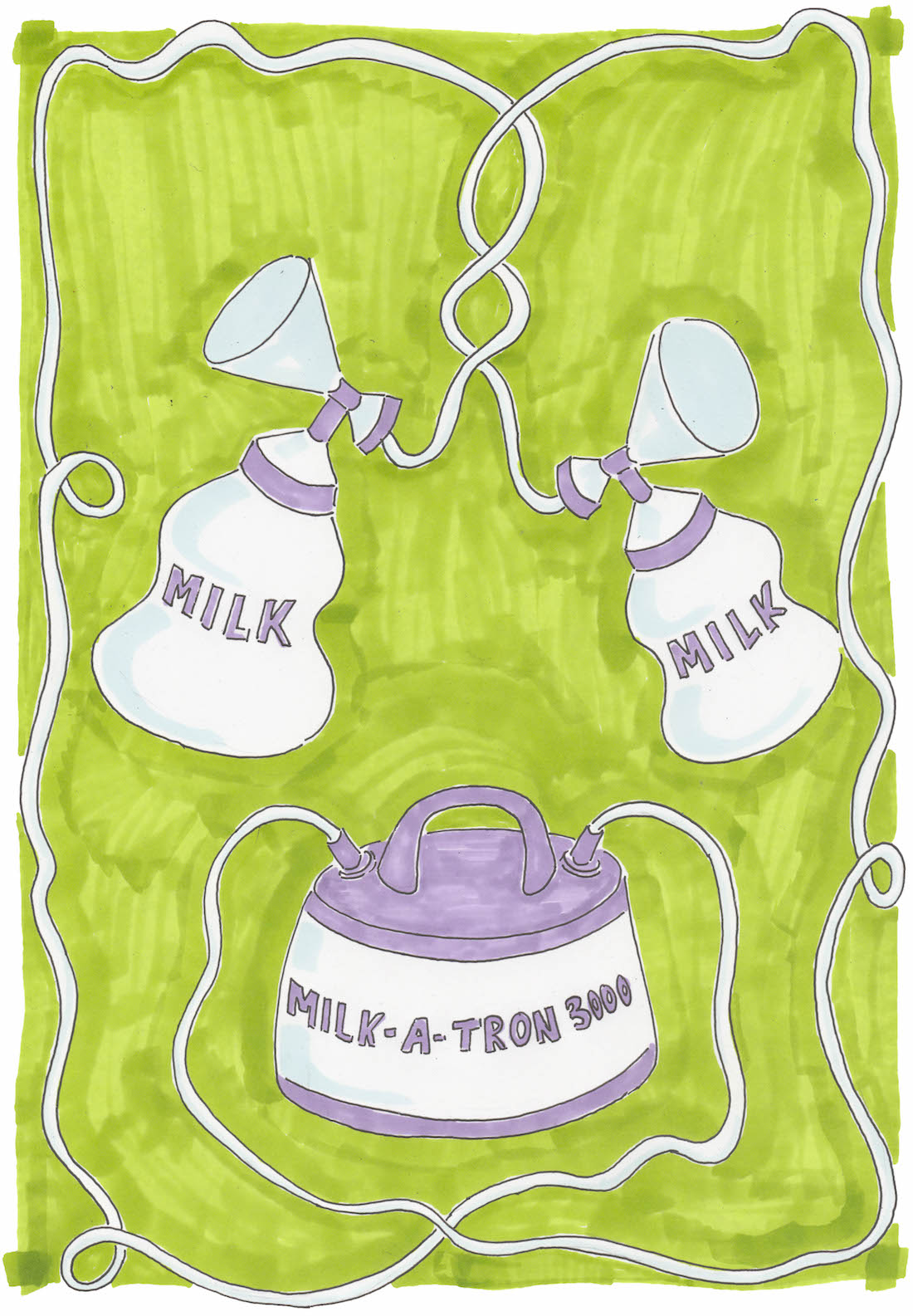 “Babe, where’s the shit pad?” my boyfriend yells from the bedroom. It’s our fourth month as parents, romance is in a dishevelled state. The shit pad in question—also known as a changing mat—is eventually located. It’s been through a lot, and is also somewhat dishevelled.
“Babe, where’s the shit pad?” my boyfriend yells from the bedroom. It’s our fourth month as parents, romance is in a dishevelled state. The shit pad in question—also known as a changing mat—is eventually located. It’s been through a lot, and is also somewhat dishevelled.
There’s not much difference between having a small baby and having a dog. There are the little bags you put their poo in, the fact they could potentially vacate their bowels in some embarrassing place at any time, and the way parents extend their babies towards each other and point, “Look, there’s another baby!” in the same way dog owners permit their pets to sniff each others’ bums. One significant difference, though, is breastfeeding, because dogs have never been chastised for that.
Two weeks ago I finally had my “breastfeeding incident”. My boyfriend was very happy for me as he knew I had been waiting for this moment. I had my vitriolic speech prepared. We were sitting in an upscale office building lobby in Tel Aviv (on a visit to our baby’s fatherland). We were safely and discreetly positioned in a corner on a large, plush leather sofa. Baby was comfortably attached and hungrily feeding when a receptionist stalked over and told my boyfriend it “wasn’t very nice for people”, and suggested we move to the sixth floor, out of view. Obviously we ignored her. There is no law about this in Israel, but there is in many other countries. In the UK, the right to breastfeed in public places is protected by the 2010 Equality Act.
“You SEE!” I scoffed at my boyfriend later. My pre-prepared speech was, of course, never declaimed to the receptionist. “It does still happen!”
Harley Weir recently put out a new photo essay called Function: photographs of the different “uses” of the female body; sexual, social and biological. In fashion-friendly pictures she confronts the confusing breast fetish of the patriarchy: nurturing nipples nestled beside erotic nipples, nipples that are sometimes OK and sometimes deemed to be obscene. There is a particularly beautiful picture of a breastfeeding baby. She also photographed a live birth. Function reminds us that a single body part traverses multiple functions in a lifetime. The series appears in the fifth issue of Baron magazine alongside the work of Page 3 photographer Alison Webster, who endorses the sexy version of breasts with her photographs.
Nursing has been a favourite subject in art history, from baroque sculptures to Renaissance painting and finally women’s depictions of the subject in the twentieth century (Mary Cassatt’s 1906 portrait is a favourite of mine) but the beautification of breastfeeding shouldn’t mislead us into believing it’s easy. A few days after giving birth I woke up looking like I’d done a body swap with Pamela Anderson. I would have enjoyed this had my ample new lady lumps not felt like Flintstones rocks. A few weeks later I was texting the wonderful Martina on Hackney’s breastfeeding helpline about my cracked right nipple. She called me back with some tips (using a dab of breastmilk to heal it worked for me). It’s not easy to lug engorged, leaking boobs around (take it from someone who was flat-chested in a former life) nor to squeeze into toilets and sweat it out with a noisy breast pump. As cool as you can be with breastfeeding, it’s not easy to expose yourself in front of strangers—or your partner’s granddad. A friend kept asking me to “try” putting our baby on her boob to see how it felt. My reaction was polite disgust, but maybe it’s not such a strange idea. We are a long way from the cultural normalization of breasts in general.
Also, it’s not just breastfeeding that makes people feel weirdly awkward. Witnessing another person eating, even as an adult, can create a strange intimacy. In Jørgen Leth’s 1964 film, Andy Warhol Eating a Hamburger (recently reimagined for millennials by Alex Da Corte, dressed as Eminem) we understand the vulnerability and pathos of the need to feed. Even the most unlikeable person suddenly looks sweet as they try to mop the sauce on their plate with a bit of lettuce. It’s as heart-wrenching to me as the drop of milk that sometimes remains on my baby’s cheek after she’s eaten. Eating reveals our human weakness. Going back to mother’s milk, eating is our need for each other.
Illustration by Rosalind Duguid





